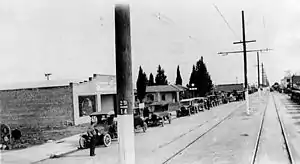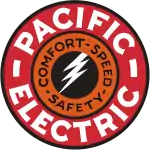Owensmouth Line
The Owensmouth Line was a Pacific Electric interurban service that connected the San Fernando Valley to Downtown Los Angeles. The route was largely developed as the result of real estate speculation.
| Owensmouth | |||||||||||||||||||||||||||||||||||||||||||||||||||||||||||||||||||||||||||||||||||||||||||||||||||||||||||||||||||||||||||||||||||||||||||||||||||||||||||||||||||||||||||||||||||||||||||||||||||||||||||||||||||||||||||||||||||||||||||||||||||||||||||||||||||||||||||||||||||||||||||||||||||||||||||||||||||||||||||||||||||||||||||||||||||||||||||||||||||||||||||||
|---|---|---|---|---|---|---|---|---|---|---|---|---|---|---|---|---|---|---|---|---|---|---|---|---|---|---|---|---|---|---|---|---|---|---|---|---|---|---|---|---|---|---|---|---|---|---|---|---|---|---|---|---|---|---|---|---|---|---|---|---|---|---|---|---|---|---|---|---|---|---|---|---|---|---|---|---|---|---|---|---|---|---|---|---|---|---|---|---|---|---|---|---|---|---|---|---|---|---|---|---|---|---|---|---|---|---|---|---|---|---|---|---|---|---|---|---|---|---|---|---|---|---|---|---|---|---|---|---|---|---|---|---|---|---|---|---|---|---|---|---|---|---|---|---|---|---|---|---|---|---|---|---|---|---|---|---|---|---|---|---|---|---|---|---|---|---|---|---|---|---|---|---|---|---|---|---|---|---|---|---|---|---|---|---|---|---|---|---|---|---|---|---|---|---|---|---|---|---|---|---|---|---|---|---|---|---|---|---|---|---|---|---|---|---|---|---|---|---|---|---|---|---|---|---|---|---|---|---|---|---|---|---|---|---|---|---|---|---|---|---|---|---|---|---|---|---|---|---|---|---|---|---|---|---|---|---|---|---|---|---|---|---|---|---|---|---|---|---|---|---|---|---|---|---|---|---|---|---|---|---|---|---|---|---|---|---|---|---|---|---|---|---|---|---|---|---|---|---|---|---|---|---|---|---|---|---|---|---|---|---|---|---|---|---|---|---|---|---|---|---|---|---|---|---|---|---|---|---|---|---|---|---|---|---|---|---|---|---|---|---|---|---|---|---|---|---|---|---|---|---|---|---|---|---|---|---|---|---|---|---|---|---|---|---|---|
 Sherman Way in Owensmouth, 1920, with Los Angeles Pacific Railroad lines | |||||||||||||||||||||||||||||||||||||||||||||||||||||||||||||||||||||||||||||||||||||||||||||||||||||||||||||||||||||||||||||||||||||||||||||||||||||||||||||||||||||||||||||||||||||||||||||||||||||||||||||||||||||||||||||||||||||||||||||||||||||||||||||||||||||||||||||||||||||||||||||||||||||||||||||||||||||||||||||||||||||||||||||||||||||||||||||||||||||||||||||
| Overview | |||||||||||||||||||||||||||||||||||||||||||||||||||||||||||||||||||||||||||||||||||||||||||||||||||||||||||||||||||||||||||||||||||||||||||||||||||||||||||||||||||||||||||||||||||||||||||||||||||||||||||||||||||||||||||||||||||||||||||||||||||||||||||||||||||||||||||||||||||||||||||||||||||||||||||||||||||||||||||||||||||||||||||||||||||||||||||||||||||||||||||||
| Owner | Southern Pacific Railroad | ||||||||||||||||||||||||||||||||||||||||||||||||||||||||||||||||||||||||||||||||||||||||||||||||||||||||||||||||||||||||||||||||||||||||||||||||||||||||||||||||||||||||||||||||||||||||||||||||||||||||||||||||||||||||||||||||||||||||||||||||||||||||||||||||||||||||||||||||||||||||||||||||||||||||||||||||||||||||||||||||||||||||||||||||||||||||||||||||||||||||||||
| Locale | Los Angeles and the San Fernando Valley | ||||||||||||||||||||||||||||||||||||||||||||||||||||||||||||||||||||||||||||||||||||||||||||||||||||||||||||||||||||||||||||||||||||||||||||||||||||||||||||||||||||||||||||||||||||||||||||||||||||||||||||||||||||||||||||||||||||||||||||||||||||||||||||||||||||||||||||||||||||||||||||||||||||||||||||||||||||||||||||||||||||||||||||||||||||||||||||||||||||||||||||
| Termini | Downtown Los Angeles Owensmouth-Canoga Park, California | ||||||||||||||||||||||||||||||||||||||||||||||||||||||||||||||||||||||||||||||||||||||||||||||||||||||||||||||||||||||||||||||||||||||||||||||||||||||||||||||||||||||||||||||||||||||||||||||||||||||||||||||||||||||||||||||||||||||||||||||||||||||||||||||||||||||||||||||||||||||||||||||||||||||||||||||||||||||||||||||||||||||||||||||||||||||||||||||||||||||||||||
| Stations | 34 | ||||||||||||||||||||||||||||||||||||||||||||||||||||||||||||||||||||||||||||||||||||||||||||||||||||||||||||||||||||||||||||||||||||||||||||||||||||||||||||||||||||||||||||||||||||||||||||||||||||||||||||||||||||||||||||||||||||||||||||||||||||||||||||||||||||||||||||||||||||||||||||||||||||||||||||||||||||||||||||||||||||||||||||||||||||||||||||||||||||||||||||
| Service | |||||||||||||||||||||||||||||||||||||||||||||||||||||||||||||||||||||||||||||||||||||||||||||||||||||||||||||||||||||||||||||||||||||||||||||||||||||||||||||||||||||||||||||||||||||||||||||||||||||||||||||||||||||||||||||||||||||||||||||||||||||||||||||||||||||||||||||||||||||||||||||||||||||||||||||||||||||||||||||||||||||||||||||||||||||||||||||||||||||||||||||
| Type | Interurban | ||||||||||||||||||||||||||||||||||||||||||||||||||||||||||||||||||||||||||||||||||||||||||||||||||||||||||||||||||||||||||||||||||||||||||||||||||||||||||||||||||||||||||||||||||||||||||||||||||||||||||||||||||||||||||||||||||||||||||||||||||||||||||||||||||||||||||||||||||||||||||||||||||||||||||||||||||||||||||||||||||||||||||||||||||||||||||||||||||||||||||||
| System | |||||||||||||||||||||||||||||||||||||||||||||||||||||||||||||||||||||||||||||||||||||||||||||||||||||||||||||||||||||||||||||||||||||||||||||||||||||||||||||||||||||||||||||||||||||||||||||||||||||||||||||||||||||||||||||||||||||||||||||||||||||||||||||||||||||||||||||||||||||||||||||||||||||||||||||||||||||||||||||||||||||||||||||||||||||||||||||||||||||||||||||
| Operator(s) | |||||||||||||||||||||||||||||||||||||||||||||||||||||||||||||||||||||||||||||||||||||||||||||||||||||||||||||||||||||||||||||||||||||||||||||||||||||||||||||||||||||||||||||||||||||||||||||||||||||||||||||||||||||||||||||||||||||||||||||||||||||||||||||||||||||||||||||||||||||||||||||||||||||||||||||||||||||||||||||||||||||||||||||||||||||||||||||||||||||||||||||
| Rolling stock | PE 5050 Class PCC Cars (last used) | ||||||||||||||||||||||||||||||||||||||||||||||||||||||||||||||||||||||||||||||||||||||||||||||||||||||||||||||||||||||||||||||||||||||||||||||||||||||||||||||||||||||||||||||||||||||||||||||||||||||||||||||||||||||||||||||||||||||||||||||||||||||||||||||||||||||||||||||||||||||||||||||||||||||||||||||||||||||||||||||||||||||||||||||||||||||||||||||||||||||||||||
| Ridership | 1,038,622 (1926)[1] | ||||||||||||||||||||||||||||||||||||||||||||||||||||||||||||||||||||||||||||||||||||||||||||||||||||||||||||||||||||||||||||||||||||||||||||||||||||||||||||||||||||||||||||||||||||||||||||||||||||||||||||||||||||||||||||||||||||||||||||||||||||||||||||||||||||||||||||||||||||||||||||||||||||||||||||||||||||||||||||||||||||||||||||||||||||||||||||||||||||||||||||
| History | |||||||||||||||||||||||||||||||||||||||||||||||||||||||||||||||||||||||||||||||||||||||||||||||||||||||||||||||||||||||||||||||||||||||||||||||||||||||||||||||||||||||||||||||||||||||||||||||||||||||||||||||||||||||||||||||||||||||||||||||||||||||||||||||||||||||||||||||||||||||||||||||||||||||||||||||||||||||||||||||||||||||||||||||||||||||||||||||||||||||||||||
| Opened | December 16, 1911 (to Van Nuys) December 7, 1912 (Owensmouth) | ||||||||||||||||||||||||||||||||||||||||||||||||||||||||||||||||||||||||||||||||||||||||||||||||||||||||||||||||||||||||||||||||||||||||||||||||||||||||||||||||||||||||||||||||||||||||||||||||||||||||||||||||||||||||||||||||||||||||||||||||||||||||||||||||||||||||||||||||||||||||||||||||||||||||||||||||||||||||||||||||||||||||||||||||||||||||||||||||||||||||||||
| Closed | June 1, 1938 (Canoga Park–Sherman Way) December 29, 1952 (all service) | ||||||||||||||||||||||||||||||||||||||||||||||||||||||||||||||||||||||||||||||||||||||||||||||||||||||||||||||||||||||||||||||||||||||||||||||||||||||||||||||||||||||||||||||||||||||||||||||||||||||||||||||||||||||||||||||||||||||||||||||||||||||||||||||||||||||||||||||||||||||||||||||||||||||||||||||||||||||||||||||||||||||||||||||||||||||||||||||||||||||||||||
| Technical | |||||||||||||||||||||||||||||||||||||||||||||||||||||||||||||||||||||||||||||||||||||||||||||||||||||||||||||||||||||||||||||||||||||||||||||||||||||||||||||||||||||||||||||||||||||||||||||||||||||||||||||||||||||||||||||||||||||||||||||||||||||||||||||||||||||||||||||||||||||||||||||||||||||||||||||||||||||||||||||||||||||||||||||||||||||||||||||||||||||||||||||
| Line length | 29.1 mi (46.8 km) | ||||||||||||||||||||||||||||||||||||||||||||||||||||||||||||||||||||||||||||||||||||||||||||||||||||||||||||||||||||||||||||||||||||||||||||||||||||||||||||||||||||||||||||||||||||||||||||||||||||||||||||||||||||||||||||||||||||||||||||||||||||||||||||||||||||||||||||||||||||||||||||||||||||||||||||||||||||||||||||||||||||||||||||||||||||||||||||||||||||||||||||
| Track gauge | 4 ft 8 1⁄2 in (1,435 mm) standard gauge | ||||||||||||||||||||||||||||||||||||||||||||||||||||||||||||||||||||||||||||||||||||||||||||||||||||||||||||||||||||||||||||||||||||||||||||||||||||||||||||||||||||||||||||||||||||||||||||||||||||||||||||||||||||||||||||||||||||||||||||||||||||||||||||||||||||||||||||||||||||||||||||||||||||||||||||||||||||||||||||||||||||||||||||||||||||||||||||||||||||||||||||
| Electrification | 600 V DC overhead line | ||||||||||||||||||||||||||||||||||||||||||||||||||||||||||||||||||||||||||||||||||||||||||||||||||||||||||||||||||||||||||||||||||||||||||||||||||||||||||||||||||||||||||||||||||||||||||||||||||||||||||||||||||||||||||||||||||||||||||||||||||||||||||||||||||||||||||||||||||||||||||||||||||||||||||||||||||||||||||||||||||||||||||||||||||||||||||||||||||||||||||||
| |||||||||||||||||||||||||||||||||||||||||||||||||||||||||||||||||||||||||||||||||||||||||||||||||||||||||||||||||||||||||||||||||||||||||||||||||||||||||||||||||||||||||||||||||||||||||||||||||||||||||||||||||||||||||||||||||||||||||||||||||||||||||||||||||||||||||||||||||||||||||||||||||||||||||||||||||||||||||||||||||||||||||||||||||||||||||||||||||||||||||||||
History
The Pacific Electric streetcar service to Owensmouth (present day Canoga Park) was part of a real estate development in Southern California.[2] Nearly the entire southern San Fernando Valley was bought in 1910 by the Los Angeles Suburban Homes Co., owned by a syndicate of wealthy Los Angeles investors, developers, and speculators: including Harrison Gray Otis, Harry Chandler, Moses Sherman, Hobart Johnstone Whitley, and others.[3] It anticipated possible connections to, but was planned independent of, the soon to be completed (1913) Los Angeles Aqueduct from the Owens River watershed to the City of Los Angeles through the San Fernando Valley in Los Angeles County.

To help promote sales of the land, General Moses Sherman's Los Angeles Pacific Railroad set off to build a streetcar line across the San Fernando Valley, to serve the three plotted new towns: Van Nuys (1911); Marion (now Reseda); and Owensmouth (now Canoga Park) (1912).[3] At the time, streetcar lines were seen as a necessity to promote development. Alongside it across the Valley westward from Van Nuys was Sherman Way: the "$500,000 paved boulevard" with lush landscaping and no speed limit where one might get up to 35 miles per hour (56 km/h), a separate dirt road for farm wagons/equipment, and telegraph lines.[3] Los Angeles Pacific Railroad later sold the line to the Pacific Electric. The line opened to Van Nuys on December 16, 1911, extending to Owensmouth on December 7 the following year.[4]
Owensmouth was named in classic real estate "boosterism", as 'nearest' the outlet-'mouth' of the Owens River Aqueduct and echoing English and New England town names such as Falmouth, Yarmouth, and Plymouth.[3] It was actually 20 miles (32 km) away when founded in 1912 and used well water instead until being annexed to L.A. city in 1917.[3] The controversy of Valley land speculation and the aqueduct brought the community to change its name from Owensmouth to Canoga Park in 1931, after the Southern Pacific "Canoga" station there.[3] The name of the Pacific Electric line was unchanged as Owensmouth until the demise of through service.
The route originally navigated the Cahuenga Pass in its own right of way on the west side of the state highway. When the Hollywood Freeway was built, the line was relocated to the freeway's median strip.[5]
.jpg.webp)
Services were truncated to North Sherman Way on June 1, 1938, and finally replaced by buses on December 28, 1952.[1][4] Unlike other lines which saw a decrease in service after World War II, ridership greatly increased in the service's final years.[4]
A survey conducted by Caltrans in 1981 reported that almost all of the line had either been removed or paved over for street use.[5]
G Line
In the 2000s a new cross-Valley rapid transit line was built: the Metro Orange Line, a dedicated bus transit-way which uses part of the old Pacific Electric right-of-way (Chandler Blvd. east of Ethel Ave.) and the former Southern Pacific south and west Valley route (from White Oak Avenue to the Chatsworth station). Service commenced in 2005; it was renamed to the G Line in 2020.
Route
Leaving Downtown on the same tracks as the Beverly Hills Line, the line continues along the Sherman Line at Sunset Junction before turning north at Highland. The line continued on its own private right of way though the Cahuenga Pass, turning up Vineland Avenue through North Hollywood, and onto Chandler Boulevard. Proceeding west to the curve onto Van Nuys Boulevard, it ran through Van Nuys to a curve (Sherman Circle) off of Van Nuys Boulevard turning west onto Sherman Way to Owensmouth. On Shoup Avenue, named after Pacific Electric president Paul Shoup,[3] the center was used as its end of the line sidings.
List of major stations
| Station | Major Connections | Date Opened | Date Closed | City |
|---|---|---|---|---|
| Owensmouth | ||||
| Van Nuys | San Fernando | 1912 | 1952 | Van Nuys |
| Lankershim (later North Hollywood) |
San Fernando | 1902 | 1952 | North Hollywood |
| Highland Avenue | San Fernando, Sherman, Venice via Hollywood | 1902 | 1955 | Los Angeles |
| Colegrove | San Fernando, Sherman, Venice via Hollywood | 1902 | 1955 | |
| Virgil Avenue | San Fernando, Sherman, Venice via Hollywood, Western and Franklin Avenue | 1902 | 1955 | |
| Sunset Junction | Beverly Hills, San Fernando, Sherman, Venice via Hollywood, Western and Franklin Avenue | 1902 | 1955 | |
| Subway Terminal Building | Beverly Hills, Echo Park Avenue, Glendale–Burbank, Redondo Beach via Playa del Rey, San Fernando, Sawtelle, Sherman, Venice Short Line, Venice via Hollywood, Western and Franklin Avenue, Westgate | 1905 | 1961 | |
Ridership
| Year | Passengers | Car Miles | Revenue |
|---|---|---|---|
| 1913 | 368,688 | 276,895 | $ 81,917 |
| 1914 | 487,907 | 378,151 | $115,228 |
| 1916 | 454,942 | 315,820 | $ 88,879 |
| 1918 | 499,282 | 381,858 | $101,452 |
| 1920 | 815,483 | 394,132 | $191,198 |
| 1922 | 795,906 | 494,037 | $202,058 |
| 1924 | 912,075 | 585,773 | $219,281 |
| 1926 | 1,038,622 | 624,206 | $225,957 |
References
- "San Fernando Valley Line". Electric Railway Historical Association of Southern California. Retrieved 8 September 2020.
- Coscia, David (2011). Pacific Electric Railway and the Growth of the San Fernando Valley. Shade Tree Books. ISBN 1-57864-735-5.
- "The Owensmouth Baby"; by Catherine Mulholland; Santa Susana Press (CSUN—California State University, Northridge); ©1987; ISBN 0-937048-42-9.
- Veysey, Laurence R. (June 1958). A History Of The Rail Passenger Service Operated By The Pacific Electric Railway Company Since 1911 And By Its Successors Since 1953 (PDF). LACMTA (Report). Retrieved 19 September 2020.
- "1981 Inventory of Pacific Electric Routes" (PDF). Caltrans. February 1982. Retrieved 3 June 2020.
